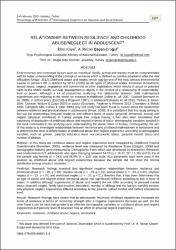| dc.description.abstract | Environmental and contextual factors such as individual, family, school and society must be comprehended well for better understanding of the concept of resilience which is defined as positive adaptation after the vital difficulties (Ungar, 2012). Childhood abuse and neglect which may be one of the most serious environmental trauma in person's life is defined by WHO (2010) as all types of physical and/or emotional ill-treatment, sexual abuse, neglect, negligence and commercial or other exploitation, which results in actual or potential harm to the child's health, survival, development or dignity in the context of a relationship of responsibility, trust or power. Although a lot of researches analyzing the relationship between child maltreatment experiences and resilience in the world, for instance in childhood (Jaffee et. all. 2007; Graham-Bermann et. all. 2009), in school years (Cicchetti & Rogosch 1997), in adolescent (Kassis et. all 2013; Perkins & Jones, 2004; DuMont, Widom & Czaja 2007) in adults (Goldstein, Faulkner & Wekerle 2013; Chambers & Belicki 1998; Campbell-Sills, Cohan & Stein 2006) only one study has been found in Turkey about the relationship between resilience and physical abuse in adolescents (Irmak, 2008). It is considered that this study aiming to find out the relationships between resilience and different types of abuse (physical, emotional, sexual) and neglect (physical, emotional) in Turkey sample has unique nature, it has also been considered that examining of distribution of childhood abuse and neglect in terms of socio-demographic variables handled in this work contributes to the studying upon understanding the abuse cases in Turkey. Consequently, the aim of this study is to investigate relationships between resilience and childhood maltreatment in adolescent and to determine the level of differentiation of childhood abuse and neglect experience according to demographic variables such as gender, parental education level, socioeconomic status, parental marital status and number of siblings. Method: In this study the childhood abuse and neglect experience were measured by Childhood Trauma Questionnaire (Bernstein, 2006); resilience level was measured by Resilience Scale (Gorgan, 2006) and demographic features were measured by Demographic Form which was developed by researcher. Research was conducted on 671 adolescents who ages changing between 14-19 (x = 16.17; SD = 1.28) and 51.1% of the sample was female (n = 343) and 48.9% (n = 328) was male. Non-parametric tests were used in the analysis as childhood abuse and neglect experiences because the sample did not show the normal distribution among research variables. Findings: Research findings revealed that significant negative relationships between resilience and emotional abuse (r = -.33, p <. 01), physical abuse (r = -.26, p <. 01), sexual abuse (r = -. 23, p <. 01), physical neglect (r = -.33, p <. 01) and emotional neglect (r = -.37, p <. 01). Besides that, it has been determined that all type of abuse and neglect except emotional abuse has significantly differed according to sex in favor of males. In addition although experiences of abuse and neglect did not differ according to parental marital status (married, single), family type (nuclear, extended), number of siblings and the family's monthly income; only physical neglect experiences differed according to the parents' (either mother and father) educational level. Result: Research findings have shown that as adolescents' traumatic childhood experiences increased the levels of resilience in terms of recovering strength after a negative experiences decrease as well. On the other hand it can be said that gender is an effective demographic variables on childhood abuse and neglect experiences and parents' level of education has an effect on physical neglect experience. | en_US |


















